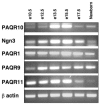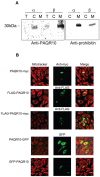Pancreatic expression and mitochondrial localization of the progestin-adipoQ receptor PAQR10
- PMID: 18769639
- PMCID: PMC2527345
- DOI: 10.2119/2008-00072.Gonez
Pancreatic expression and mitochondrial localization of the progestin-adipoQ receptor PAQR10
Abstract
Steroid hormones induce changes in gene expression by binding to intracellular receptors that then translocate to the nucleus. Steroids have also been shown to rapidly modify cell function by binding to surface membrane receptors. We identified a candidate steroid membrane receptor, the progestin and adipoQ receptor (PAQR) 10, a member of the PAQR family, in a screen for genes differentially expressed in mouse pancreatic beta-cells. PAQR10 gene expression was tissue restricted compared with other PAQRs. In the mouse embryonic pancreas, PAQR10 expression mirrored development of the endocrine lineage, with PAQR10 protein expression confined to endocrine islet-duct structures in the late embryo and neonate. In the adult mouse pancreas, PAQR10 was expressed exclusively in islet cells except for its reappearance in ducts of maternal islets during pregnancy. PAQR10 has a predicted molecular mass of 29 kDa, comprises seven transmembrane domains, and, like other PAQRs, is predicted to have an intracellular N-terminus and an extracellular C-terminus. In silico analysis indicated that three members of the PAQR family, PAQRs 9, 10, and 11, have a candidate mitochondrial localization signal (MLS) at the N-terminus. We showed that PAQR10 has a functional N-terminal MLS and that the native protein localizes to mitochondria. PAQR10 is structurally related to some bacterial hemolysins, pore-forming virulence factors that target mitochondria and regulate apoptosis. We propose that PAQR10 may act at the level of the mitochondrion to regulate pancreatic endocrine cell development/survival.
Figures




References
-
- Razandi M, Pedram A, Levin ER. Plasma membrane estrogen receptors signal to antiapoptosis in breast cancer. Mol Endocrinol. 2000;14:1434–47. - PubMed
-
- Simoncini T, et al. Novel non-transcriptional mechanisms for estrogen receptor signaling in the cardiovascular system: interaction of estrogen receptor alpha with phosphatidylinositol 3-OH kinase. Steroids. 2002;67:935–9. - PubMed
-
- Luconi M, et al. Characterization of membrane nongenomic receptors for progesterone in human spermatozoa. Steroids. 2002;67:505–9. - PubMed
-
- Simoncini T, Genazzani AR. Non-genomic actions of sex steroid hormones. Eur J Endocrinol. 2003;148:281–92. - PubMed
Publication types
MeSH terms
Substances
LinkOut - more resources
Full Text Sources
Molecular Biology Databases
Miscellaneous

